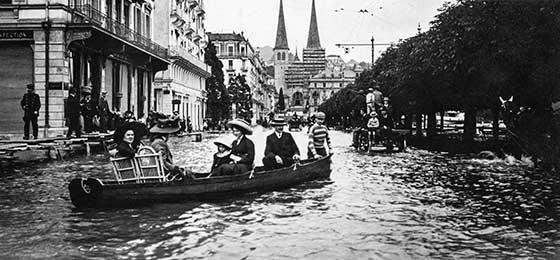Marketing disasters

(From "Horizons" no. 111 December 2016)
The bourgeoisie – locals and tourists – are shown here cruising in obvious amusement across the Schweizerhofquai in Lucerne in June 1910. Both the River Reuss that runs through the town and Lake Lucerne itself had broken their banks, and the water remained high for five days. "This picture was very much staged, as was the custom at the time", says Christian Rohr, a climate historian at the University of Bern. He is responsible for archiving historical photos of natural catastrophes. For him, they are an important source of urban and environmental history.
The flood was indeed marketed as an event, and the atmosphere in the city was compared with that of Venice. But the water wasn't actually that high: "It only reaches up to the knees of the boy in the striped pullover". The ground was probably dry just a few yards to the left, where the streets slope upwards. And while some people earned money from the flood, others were ruined because cellars and stockrooms were flooded, and entranceways blocked.
The photo also tells another story. When the Hotel Schweizerhof was built in the second half of the 19th century, a broad strip of land was filled up to form the quayside where once the landing stage for the lake had been. It was the time when Lucerne was experiencing an upswing on account of the arrival of the railways, and the city itself was expanding rapidly. "The bourgeoisie wanted to be close to the city centre, yet also wanted to live in green surroundings", says Rohr.
It's also instructive to consider what these early photos of natural disasters don't show. "Up to the First World War, almost none of the fatalities of natural disasters were shown, for reasons of respect", says Rohr. Even on the photos of the earthquake of San Francisco in 1906, the only dead people you see are those who were tried and shot for looting.hpa